its paid sponsors, whose products you need!
| Home |
| Intro |
| Current Issue |
|
Mailing List |
| Store |
| Strength |
| Subscriber Content |
| ARCHIVES
|
| Martialism |
| Pacifism |
| Q & A |
| Cunning-Hammery |
| Advertise With Us |
| Submit An Article |
| Staff |
| Discussion Forum |
| Links |
“Stay ‘unreasonable.’ If you
don’t like the solutions [available to you], come up with your
own.”
Dan Webre
The Martialist does not
constitute legal advice. It is for ENTERTAINMENT
PURPOSES ONLY.
Copyright © Phil Elmore, all rights
reserved.
Coach Sonnon and Softwork
Interview by Phil Elmore; photographs
provided by Scott Sonnon
An internationally recognized
authority on physical culture and martial art, Coach Scott Sonnon is well
known to the SAMBO and Russian martial arts communities as well as in strength
and conditioning circles. His Circular Strength Training (CST)
program (which uses weighted clubs called Clubbells) is practiced
by many performance athletes (not to mention hundreds of martial artists,
bodybuilders, and everyday people seeking better health). He has published
numerous books and videos on fitness, conditioning, and the removal of
psychological and physiological barriers to ones performance as a “combat
athlete.” No longer content simply to pursue “performance enhancement” in his
teaching, Coach Sonnon recently announced his latest curriculum: Softwork, an internal system of martial art he has pioneered and developed over
the course of his career.
The Martialist: For some time
now youve been positioning your video and text programs as “performance
enhancement” a means of making every athlete better. What has changed?
Scott Sonnon: For years I was
describing the movement between techniques. That is what I meant by
“performance enhancement” improving flow from one technique to
the next. The word “to” presumes something small and innocuous, but that is
the bulk of not just training, but fighting. Everything happens in between.
The problem with pursuing this approach is that an entire
field of “performance enhancement” has sprung up. Its my fault. I was going
to people and saying, “I can help you do what you are doing and help you be
better at it, heres how. I can help you seam together the movement in
between what you are studying.” Theres a specific process for doing that.
What they did, however, was kindly agree then shore up what they were
already doing, using my methods but not embracing my methodology. Because
I was only teaching them to improve the “to,” the bits in between, they were
free to claim they hadnt been studying anything else. That gave them what
they saw as license to claim they were not doing anything extra, not doing
anything new.
I no longer say that what Im teaching is the movement in
between. I am now at the point where Im in peoples faces, telling them
what I am teaching is something completely and radically new, something
confrontational to traditional martial arts. I am teaching the absence
of technique, anti-technique. There is no rote technique memorization in
Softwork.
The M: Can you describe how
Softwork works?
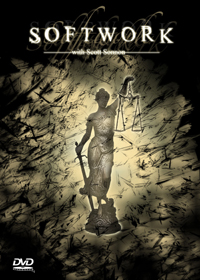 Sonnon: Those operating in
Sonnon: Those operating in
Softwork are not reproducing their own techniques. It is impossible
to do the same maneuver twice within the drills, and in life itself. I
provide a formula for students to create their own techniques,
spontaneous to the situation. Softwork presumes, “You are the master, always
and already, of your own style.” If one studies someone elses style,
one picks up someone elses filters, baggage, and impediments. For people to
presume that one can even learn the “style” created by another assumes that
movement is repeatable, that life is stagnant and transferable. It is
that
which no one would dare argue. There is no wisdom without personal
experience. That is the goal of Softwork: to provide the experience of
discovery.
The M:
Isnt that what learning a martial art is all about
refining the performance of techniques?
Sonnon: Conventional wisdom
assures one that there is such a thing as muscle memory, that you
repeat a certain maneuver until it becomes ingrained, until it establishes a
more thorough neuromuscular path. However such a belief system disintegrates
in the face of stress, such as a suddenly violent conflict. The “rote
technique” educational approach does not work in martial art because of the
presence of arousal fear and surprise and your reactivity to it. The
first premise of Softwork is that it is not possible to reproduce the same
motion in general and that reproducing even a remote approximation under
stress is nearly impossible. This is because the “technique” was captured, not in the
“muscle memory” (which does not exist), but rather in fantasies of the
cognitive mind. There is no such thing as rote technique outside of that
neurotic fantasy, because cognition breaks down under the stress of conflict. If a
“technique” depends on cognition, then its not accessible, controllable, or
proportional in conflict of any kind
and frankly, it’s negligent,
because it neither
addresses the individuals performance nor the individual’s survivability.
The M:
How can you teach a style that is improvised? On what do you
base what you teach?
Sonnon: How can others teach
something which is not? All things are improvised. It is only the
belief
that a “technique” is “known” that creates the hazardous illusion of
confidence. Any educational system that does not set as its presupposition
improvisation is problematic, because to assumes “knowns” (especially in the
fog and friction of conflict) is to enter a fight wearing “Emperors Clothes.”
Students of Softwork explore drills rather than “rehearse”
techniques. For example, consider shock absorption. When you practice shock
absorption, youre learning how to absorb blows with your torso. As you learn
to pocket around the incoming force and move askew to avoid most or some of
the force of that blow, youre developing your own personalized response to
that particular attack. Youre teaching yourself to move in response to the
presence of force, rather than the expectation of deploying some “technique in
your repertoire.”
Rather than using block A in response to Attack X, rather
than getting caught in that decision tree of, “If this, then that,” you
learn to absorb force to allow your body to respond creatively in a way thats
appropriate. This is why one ought not teach some pedantic codification of
rote “joint locks,” but rather discuss the potential of the joint, demonstrate
a few examples of how to act on that knowledge, and then systematically
immerse oneself within incrementally progressive resistance drills to
inculcate that kinesthetic awareness. When you understand how to improvise
solutions, youre not relying on rote memory and you reclaim your natural
adaptability to stress, to arousal.
The conventional martial art approach is that your body is a
dumb machine that has to be directed by your cognitive mind. It defies the
notion of our nervous system and biochemistry. The higher the stress, the
less likely were consciously involved in the situation. So, if we need to
consciously select “techniques” (and, moreover, think about how to create a “variation” of the technique to
“apply” it to the reality of the situation),
we are not only at a loss in a crisis, but suffer perhaps even a mortal
blow because of the bulky, ineffective educational process (“rote technique”)
we’ve been taught.
However, if were trained to respond at an intuitive level,
we have a faster route to efficacy. As a matter of fact, its the only
route. Anyone familiar with my instructional programs knows that we perform a
lot of drills drills that increase in complexity and sophistication, that
then introduce combat multipliers that move from static to fluid to
dynamic. It is through such practice that you develop intuitive response,
rather than inculcate a predesignated technical plan.
The M:
So there can be no “wrong” way to do a Softwork technique, as
long as it works?
Sonnon: A technique can be a
good habit or a bad habit, but it is always only a habit. It erupts without
discrimination, without proportionality, and most often free of appropriate context to
reality. We must have NO habits. To do this we need experience, not
memorization. For example, how do you learn that you need a “counter”
technique? You learn it through experience. You dont learn that you have to
stop doing something until you have the experience for it, until you see the
necessity. The whole purpose of drills is to make mistakes. If youre
not making mistakes, if youre constantly able to avoid confronting mistakes,
youre defeating the purpose of the drill. That spells disaster for the
person because conflict isnt about succeeding, but rather recovering more
quickly than the other person from perceived errors, surprise, and shock. Who
cycles faster wins. The whole purpose of a Softwork drill is the
physical expression of critical thinking. If the drill’s parameters say that
you are not permitted to do the same things twice, you cannot develop a bad
habit because you are not repeating the same maneuvers.
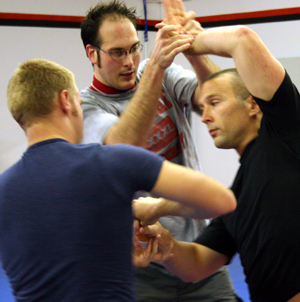
Scott Sonnon (right) works with students.
The M: What is Softwork,
then? Do you consider it a new martial art style? Is it based on your SAMBO
and Russian martial art experience?
Sonnon: Whatever I create is
going to be partially an amalgam of everything Ive experienced. Its
impossible for me to say, “No, SAMBO had nothing to do with this.” My
experience in SAMBO did. Thats not to say the systems have, because the
systems have not. Ive learned from my mistakes. That evolution is the
creation of Softwork.
Last year, I resigned from my position as Director of the
American Annex to the Russian Federation of Russian Martial Art (ROSS).
Political reorganizing in Russia required recertification for all ROSS
instructors. I did not agree with the direction in which it was headed,
including but not limited to codification of technical content into a ranking
structure. The spirit of this did not coincide with my personal philosophy;
espoused by the materials I have published, the
seminars I teach, and the
“tribal” concept I foster. I do not fault my coach for the direction those in ROSS have chosen to go, but I cannot go with them.
Furthermore, the veil of mysticism and cult-like tendencies
of cultural martial traditions engenders problematic political obstacles. I
stepped out and away from that nonsense, because it impedes the clarity of the
message and competes with the practitioner’s ability to transcend
his or her current condition. Half of what one must address at the beginning is
holding a mirror to the perverse preconceptions generated from mystical
propaganda in cultural martial traditions. Stepping away to forge a “universal system, devoid of cultural attaché, allows us the luxury of
speaking directly to the human experience, rather than needing to sift through
the vagaries of a particular culture and religion.
The M:
So youve cut your ties to ROSS, to SAMBO, and to Russian
Martial Art in general?
Sonnon: Yes. An ancillary
issue to this regards the consistent piracy of my work by practitioners of
“Russian Martial Art.” For some reason, there is this phenomenon in the martial
art “industry.” People assume that because I was the Director of the American
Annex to the Russian Federation of Russian Martial Art, that means if
they practice any type of Russian Martial Art, my proprietary systems, in part
and in some morally repugnant cases in whole, are theirs for the taking, with
no credit or source citation. In some cases, before legal action ceased their
infringements, they even made commercial gain from my proprietary work.
What has been published and copyrighted by RMAX.tv
Productions is the sole property of RMAX.tv Productions. The intellectual
property it protects is not written or seen anywhere else but within its
materials.
The same happens with the Circular Strength Training
System, which is the foundation of all martial art development through RMAX.
People believe that because “Indian clubs” have existed for centuries,
my work and Clubbells® must be “public domain.” No, actually, it’s my research, development,
system, and property because I created and systematized it. People have such
lunatic irrationality. Their argument is akin to this: Henry Ford did not
invent the combustible engine; therefore we can copy the 2005 Ford Mustang.
People need to sign up for a logic course at their nearby community college.
I never claimed to invent Russian Martial Art and I never
claimed to invent Indian clubs. I have indeed invented the patented Clubbell®
and have indeed trademark protected my proprietary systems. Any thieves who
wish to challenge my trademarks and patents and prove (beyond “keyboard
jockeying”) that my work is unoriginal are welcome to speak to my staff of
attorneys. Those who attempted to create knock-offs discovered very quickly
the recourse my company will go to in order to protect such infringements.
The M: Lets be clear on that, then. RMAX is not
“Russian Martial Art?”
Sonnon: No. RMAX is not
“Russian Martial Art” and its materials are unique and my own creation, as
are its trademarks uniquely owned and protected by RMAX.tv Productions.
This was a very frustrating issue at the time. The
only way I saw to rectify it on both accounts was to resign from the
organization and continue to go my own way, as I always have and always will.
I will no longer be teaching at ROSS camps, nor promoting their events. Now, its out of my hands. RMAX.tv Productions legal department handles these
issues. Now Im completely free to concentrate on research and
development, training operations, and, frankly, spending the rest of my time
playing with my children.
The M: What does that mean
regarding your relationship with the American Annex?
Sonnon: I had spoken with the directors of the American Annex,
asking them if
they wished to continue to use RMAX proprietary systems to augment their
education within ROSS Training System. They may, as many martial art styles
do, with proper citing, credit given. I have no other relationship to the
American Annex, nor to RMA in general.
The M: Your resignation hasnt
ended the issue, however. Softwork is being embraced by at least a portion
of the Russian Martial Art community, in whatever form.
Sonnon: True. We’ve attracted a great deal of attention from
enthusiasts of a Russian Martial Art called “Systema” since the release of the Softwork DVD. A number of issues have arisen as a result of this: Negative
issues including anonymous cowards on the Internet issuing death threats and hate
mail directed at our members, and supposedly “positive” individuals claiming
that they consider Softwork to be a better way of ‘explaining’ and ‘tweaking’
Systema. This is another way of saying, “were taking Softwork and teaching
it but calling it Systema.”
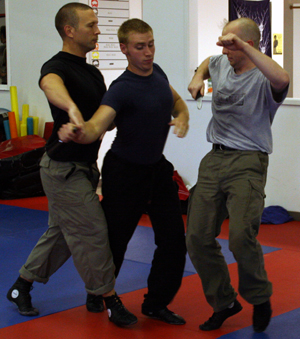
Coach Sonnon and his seminar attendees…
Let me be perfectly clear: Softwork is not “Systema.” I’m
flattered that some people resonate with my work to the extent that they
immediately want to incorporate it into what they do (although this indicates
that they completely miss the POINT about our community). Its great that they
feel transformed by their RMAX experience. However, there are several errors
in logic here that are leading to confusion and friction.
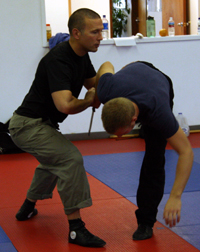
…working with knives…
I believe the first problem stems from my extensive
background in Russian SAMBO (in the English language this acronym translates
to “Unarmed Self-Defense”) and R.O.S.S. (in the English language this acronym
translates to “Russian Native Self-Defense System”).

…in the context of Softwork.
The fact that a person who is teaching a different system of
Russian Martial Art and I may have had similar training experiences does not
lead to the conclusion that we are doing the “same thing.” Despite the fact
that “Systema” and “Russian Martial Art” are registered trademarks, in Russia
there are as many “Systema” as there are “Russian Martial Art” systems: Kadochnikov, Belov, Spas, Skobar, Sobor, Buza, Golitsin, ROSS, RRB, Kolo,
Rukopashni Boi, Ryabko, Sidorov, Slavyano Goretskaya Bor’ba, et cetera. In
recent years this list has grown beyond what I experienced.
This is analogous to me traveling to the country of “Khmer” and
starting to teach the “American martial art” called “Style.” Style would be
very inclusive and eclectic. If one ever encountered any endemic research
which would help one teach Style to the indigenous people, one could
incorporate it. If another “American” immigrated to “Khmer” who taught a
different flavor of “Style,” the first “Style” could just explain that
its “all just Style” and then assimilate any unique research of the second “Style.” Its a very perverse cult branding technique.
The M: What is RMAX, then?
Sonnon: RMAX is an acronym for
“Reaching OuR MAXimum Potential Together.” No one has previously published
anything that I have: Shock Absorption, Inoculation and Engineering, Arthrokinetics, Joint Mass Center, Leg Fencing, Jacket Fencing, Myofascial
Tensegrity applications to Fear-Reactivity, Tension Chains and Density,
Flow-State Performance-Spiral for Emotional Control, Flow Fighting for Mental
Toughness, Body-Flow, Performance Breathing “Be Breathed”, Warrior
Wellness Sophisticated Dynamic Joint Mobility
its a long list of
proprietary systems. There are individuals who claim that others were doing
what I am doing, and were explaining it the way that I explain it, before I
published it. In the erudite imperative of the academic Ivory Tower, I say: put up or shut up. Whoever publishes first is recognized as the originator
of that work because of this nonsense of arbitrary claims of “doing it prior”
without proof.
Unlike certain other “professionals” who claim that what
they do is an “eclectic combination of various undisclosed influences, I
exhaustively cite my sources and my specific, verifiable history.
The M: Is there some sort of
animosity among you, Softwork, and Systema, then?
Sonnon: None that is my
doing. For some perverse reason, people who have become disgruntled, ejected,
or self-deselected from the “official Systema” are coming to RMAX in droves
for asylum. It seems that they consider me some sort of de facto anti-Systema
leader. Thats wrong. I was even offered a t-shirt once. At first I
misunderstood. I thought they were offering me an “RMAX” shirt that theyd
made until they explained, “no, its XRMA, as in ex-RMA.” Perhaps this was
merely an attempt at joking, but let’s be serious for a moment and set the
record straight. I have no interest in “Systema,” either in the positive or in
the negative. Whatever severe internecine conflict that organization endures
has absolutely no bearing or reflection on me.
For that matter, I have no idea what any “Systema
teaches and, frankly, I don’t care. I indict any cultural martial
tradition as problematic. So, although those bombarding RMAX with controversy
are generating massive volumes of business sales, please stop trying to educate
me on why you think that what I teach is just a ‘better way of explaining’ how
your ‘teachers’ move. I was not put on this planet to help you figure out why
you are told that you will never be able to do anything but approximate the “masters” mysterious abilities. RMAX and Softwork are not about someone
else’s mastery. They are about cultivating ones own mastery.
The M:
Lets get back to Softwork as a system. You say you train to
make mistakes?
Sonnon: Softwork is a system
of deliberately making mistakes so you can experience them and learn to adapt
to them. It is putting yourself in disadvantageous positions so you can
discover solutions. The faster you can recover from your perceived errors and
from the unexpected, the better you will flow and the more effective a
fighter you will be. This is the key to improvising your own techniques based
on the situation.
The M: Whats a Softwork class like?
Sonnon: When a person gets
into one of my seminars, the first thing they need to learn is to integrate
their breathing, structure, and alignment. I have two processes. The first is
Body-Flow, the solo work. Then the soft and hard work comes, in which youre
learning to capitalize on the disintegration of an opponent or partners
breathing, structure, and alignment.
The M: But isnt what you do
in a drill a technique?
Sonnon: Yes, of course. The
key is that you are learning to spontaneously create a technique, which
is the complete polar opposite to “memorizing a rote technique.” In order to
do anything, you use technique, but you can never repeat that technique
physics says so. It is rote technique that is the flaw in martial art
education.
The M: Can you describe what
this is like?
Sonnon: We do a drill in which
partners balance on one leg. Walking is itself an act of weight transfer and
balance. The same is true of any strike, any kick, any takedown its all
grounded from one leg. Theres a support or drive leg and a mobile or free
leg. Any force transfer comes from that supporting or driving leg. If that
is true, in the drill we first learn how to absorb strikes. Were not very
intensive on the proper manner of hitting so much as we say, “Okay, heavy and
deep. Relax into the strike, work on exhalation, work on keeping your
structure intact.”
When they are absorbing blows, the person applying the blows
is instructed in the way the body works. You know, if you hit the person
here, the hip collapses and folds, the pelvis tilts, it changes the high
tension support system that keeps the person from falling over, et cetera.
The M: Many traditional arts
are based on an understanding of how the body works, though.
Sonnon: Any type of conflict
engagement is dynamic. This is also getting to the point that
conventional martial arts are based on the beliefs held in Newtonian physics.
The issue here is that kicking a soccer ball and a kicking a Rottweiler are
not the same thing. In the former, its an (apparently) inanimate, simple
object, lending the appearance of predictability that to every action there
is an opposite and equal reaction. However, in the latter case, the dog is a
sophisticated creature with consciousness that, as weve learned in quantum
physics, affects everything in the universe, even down to a subatomic level.
The interaction with the dog is not predictable and if you try to kick him, youll probably get your foot chewed off. The goal of Softwork is to help
the participants to develop an intuitive blueprint for feeling what to
do in a given dynamic situation.
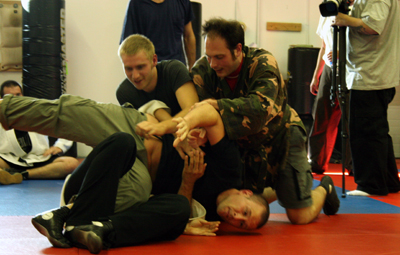
Coach Sonnon hits the mat with seminar attendees.
The M: How else, then, is
Softwork different from what you call “conventional” martial art?
Sonnon: Softwork is derived
from an understanding of the human organism, rather than imposed on it. The
people who created martial arts styles were just good at teaching. They were
good marketers. They had and have no special insight. I have no special insight into
the human condition other than what my training offers me. Each and every
person is just as capable of reclaiming and refining their self-mastery as any
so-called “master.” Comments that you wont understand unless you are of such
and such culture, such and such blood, such and such soul/religion, are merely
cultish propaganda. The argument, of course, is that one can elect to learn
from a cult leader without being involved in the cult. Their logic is
analogous to saying that one can learn something “positive for humanity” from
the inhumane atrocities performed on Jewish people by Nazi German “scientists” without being a Nazi. Its lunacy.
The M: Statements like that
are bound to upset many martial artists.
Sonnon: Im not here to make
“martial arts” comfortable in their beliefs, especially when those beliefs are
not only a danger to others, but to themselves. Its only “bad news” to those
who stand to lose in status, finance or in “ego.” For everyone else, this is
the best news imaginable.
The M: What is that message?
What is that news?
Sonnon: Self-mastery is no
longer the domain of special “priests” who alone can show you “The Way.”
Self-mastery already and always belongs to each and every person awaiting them
to reveal it. It is that, not only can people tap their own mastery, but they
can tap it in a short amount of time. The rote technique model is
inefficient, awkward, and unnecessarily lengthy. Give me two years with
someone consistent and diligent, not decades in a cultural martial tradition.
Moreover, with such expedience and universality, every individual has access,
not just the few who can disregard finance, family, and personal health in
order to transcend that ineffective model.
The M: How is that possible?
Sonnon: Traditionally, just
before mastery, you abandon technique and transcend it. Why arent eighty to
ninety percent of martial arts people masterful? Why is it the exception?
Why is it that most instructors are not masterful in their motion?
There is another model that can be followed. If you look at the evolution of
martial arts styles, I believe there is a “conspiracy of technique.” That
conspiracy, that devotion to rote technique among so many instructors, is a
way to appease the masses. If you must abandon and transcend technique in
order to “attain” mastery in the traditional model, then take out the
problematic step: if you remove rote technique, you wont need to transcend
it!
The M: So cultural martial
traditions are not just inadequate theyre a means of duping students?
Thats quite an accusation.
Sonnon: As opposed to what
martial arts “masters” claim, I can have someone approximate my movement level
in a short amount of time. I empower them to be unlimited. Just
listen to the choking conventional wisdom you hear in a martial arts school.
“Well, you have to apply the technique to your body, adapt it.” Logic says it
cant be both A and not A. Its this technique or its not this
technique. Why dont we start by teaching people to adapt, rather than
teaching a technique and learning how to adapt it, causing decades of
anguish trying to figure out the right way to do Masters technique? Removing
the problematic step of conventional training eliminates decades of “trying”
to sift through the codified dogma and allows one to go directly to “flow.”
The M: You are the center of a
great deal of controversy, Scott. Based on these statements its easy to see why.
Why do you think this is so?
Sonnon: I call into question
the core values of what it means to be a martial artist in the
conventional notion. I didnt create a new style; in RMAX, I have created a
new idea. Everyone could create a new style if they used RMAX as a
meta-formula for generating experience. Theres a direct formula for this.
And of course that calls into question every individual who holds himself to
be an expert, but it also calls into question everyone whos
following an “expert.” Stop following and start leading! You are already
and always a master if you tap it.
The M: Well, youve certainly
given us a lot to think about. Thank you. Any parting words?
Sonnon: Every person is my
partner, not my student. Be a bad student and a good partner. Dont be a
follower.
Look into a mirror, not an oracle.
